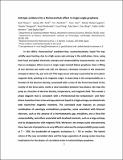Entropic evidence for a Pomeranchuk effect in magic-angle graphene
Author(s)
Rozen, Asaf; Park, Jeong Min; Zondiner, Uri; Cao, Yuan; Rodan-Legrain, Daniel; Taniguchi, Takashi; Watanabe, Kenji; Oreg, Yuval; Stern, Ady; Berg, Erez; Jarillo-Herrero, Pablo; Ilani, Shahal; ... Show more Show less
DownloadAccepted version (4.278Mb)
Publisher Policy
Publisher Policy
Article is made available in accordance with the publisher's policy and may be subject to US copyright law. Please refer to the publisher's site for terms of use.
Terms of use
Metadata
Show full item recordAbstract
In the 1950s, Pomeranchuk1 predicted that, counterintuitively, liquid 3He may solidify on heating. This effect arises owing to high excess nuclear spin entropy in the solid phase, where the atoms are spatially localized. Here we find that an analogous effect occurs in magic-angle twisted bilayer graphene2-6. Using both local and global electronic entropy measurements, we show that near a filling of one electron per moiré unit cell, there is a marked increase in the electronic entropy to about 1kB per unit cell (kB is the Boltzmann constant). This large excess entropy is quenched by an in-plane magnetic field, pointing to its magnetic origin. A sharp drop in the compressibility as a function of the electron density, associated with a reset of the Fermi level back to the vicinity of the Dirac point, marks a clear boundary between two phases. We map this jump as a function of electron density, temperature and magnetic field. This reveals a phase diagram that is consistent with a Pomeranchuk-like temperature- and field-driven transition from a low-entropy electronic liquid to a high-entropy correlated state with nearly free magnetic moments. The correlated state features an unusual combination of seemingly contradictory properties, some associated with itinerant electrons-such as the absence of a thermodynamic gap, metallicity and a Dirac-like compressibility-and others associated with localized moments, such as a large entropy and its disappearance under a magnetic field. Moreover, the energy scales characterizing these two sets of properties are very different: whereas the compressibility jump has an onset at a temperature of about 30 kelvin, the bandwidth of magnetic excitations is about 3 kelvin or smaller. The hybrid nature of the present correlated state and the large separation of energy scales have implications for the thermodynamic and transport properties of the correlated states in twisted bilayer graphene.
Date issued
2021Department
Massachusetts Institute of Technology. Department of PhysicsJournal
Nature
Publisher
Springer Science and Business Media LLC
Citation
Rozen, Asaf, Park, Jeong Min, Zondiner, Uri, Cao, Yuan, Rodan-Legrain, Daniel et al. 2021. "Entropic evidence for a Pomeranchuk effect in magic-angle graphene." Nature, 592 (7853).
Version: Author's final manuscript